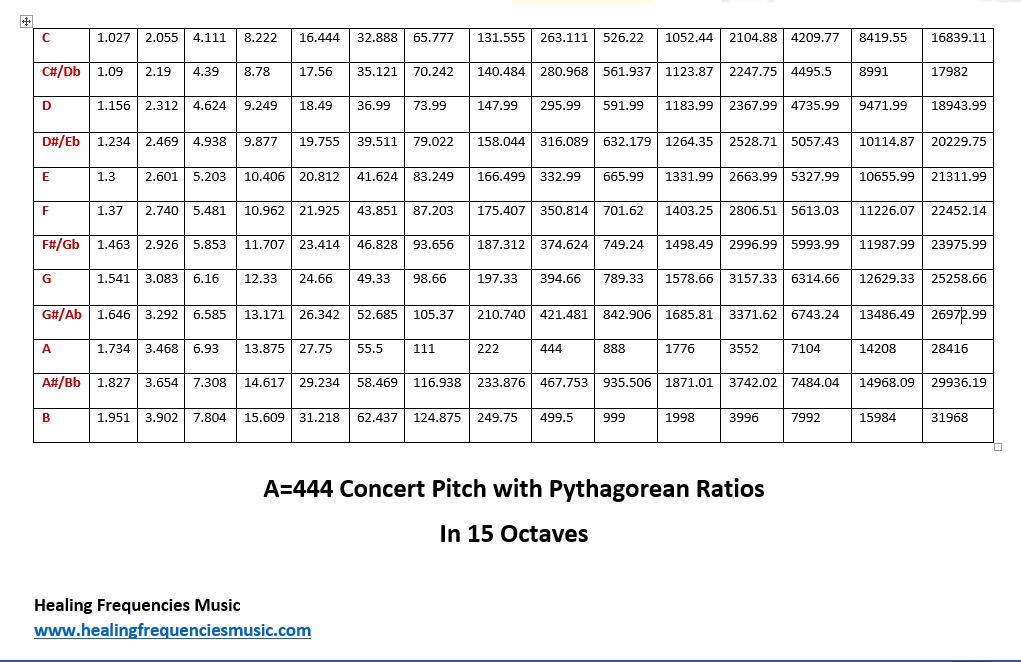The idea of 444Hz tuning and its association with the Solfeggio frequency 528Hz is a common misconception rooted in an incompatibility between tuning systems. The Solfeggio scale and Pythagorean tuning both create intervals in music, but they follow distinct calculation principles that lead to different frequencies, resonances, and results. This article explores why 444Hz tuning doesn’t naturally align to make C equal to 528Hz and why using Pythagorean calculations for Solfeggio frequencies is inherently inaccurate.


Understanding Pythagorean Tuning and Scale Construction
The Pythagorean tuning system is based on stacking perfect fifths (a 3:2 ratio) to create musical intervals. This means that each step up a fifth generates a new pitch that forms part of a musical scale. When enough fifths are stacked, the resulting intervals produce tones that generally align well with the harmonic series, giving them a natural consonance. However, Pythagorean tuning was designed for melodic and harmonic purity and not for any specific numerological or healing purpose.
Key characteristics of Pythagorean tuning include:
- Consonance in perfect intervals, like fifths and octaves, due to the exact mathematical relationship.
- Minor imperfections in thirds and other intervals compared to systems like equal temperament, making it suitable for traditional musical scales but limited for precision in unique tonal requirements.
Using this system to try and tune C to 528Hz is problematic. In Pythagorean terms, if we want C to equal 528Hz, we would need to raise the reference note A to an impractical frequency like 888Hz, which disrupts the traditional structure and tonal balance.
The Solfeggio Scale: A Different Approach to Tuning
The Solfeggio frequencies are a set of specific tones (e.g., 396Hz, 528Hz, 639Hz) that have been assigned unique properties and often have numerological significance rather than following harmonic relationships. The origin and purpose of these frequencies are based on a different foundation than typical Western musical intervals. Unlike Pythagorean or even equal temperament tunings, the Solfeggio frequencies are not calculated based on stacking perfect fifths or thirds; rather, they follow a sequence tied to numerological principles. This unique construction means they don’t fit neatly into any standard musical tuning system.
For example:
- 528Hz is often associated with transformation and healing in Solfeggio-based practices, yet it doesn’t conform to the 3:2 ratio structure found in Pythagorean tuning.
- The frequency progression in the Solfeggio scale does not align with Pythagorean calculations, as it is not dependent on traditional harmonic or interval-based relationships.
Why Pythagorean Calculations Cannot Be Used for Solfeggio Frequencies
Attempting to calculate Solfeggio frequencies using Pythagorean methods is like trying to fit a square peg into a round hole. The Pythagorean method structures intervals based on stacking fifths and achieving mathematical precision in consonance. Solfeggio frequencies, however, arise from distinct principles with specific numerical and symbolic values, making them incompatible with Pythagorean calculations.
This means:
- Misalignment in Harmonics: Solfeggio frequencies are derived from a unique system that does not align with the harmonic stacking of fifths (3:2 ratio) fundamental to Pythagorean tuning.
- Numerology vs. Harmonic Ratios: Solfeggio tuning is based on number sequences that often don’t correspond with the harmonic relationships defined by Pythagorean mathematics.
- Incorrect Results: When using Pythagorean tuning to replicate Solfeggio frequencies, the calculated values fall short of the Solfeggio targets, resulting in a different sound and frequency experience.
Conclusion
Calculating Solfeggio frequencies using the Pythagorean system is inherently flawed. While the Pythagorean method is well-suited for constructing traditional musical scales, it cannot accurately produce the Solfeggio tones, which rely on numerological sequences and symbolic meanings rather than harmonic stacking. For practitioners seeking the unique benefits of Solfeggio frequencies, it’s essential to use their designated values (e.g., 528Hz) and avoid recalculating them with alternate tuning methods. Using Pythagorean tuning for these frequencies leads to an entirely different result, losing the specific resonant qualities that make the Solfeggio scale unique in sound healing practices.
Understanding the distinctions between Pythagorean tuning and Solfeggio frequencies is essential for anyone exploring the profound effects of sound on healing and wellness. While Pythagorean intervals resonate through structured harmonic ratios, the Solfeggio frequencies, including the renowned 528Hz, derive from numerologically driven frameworks intended for unique energetic impacts on the body and mind. For a more in-depth look at the power of frequencies and their therapeutic applications, visit PEMF Healing to explore advanced PEMF therapy options and PEMF Magazine for insights into frequency science, healing technology, and holistic health.

